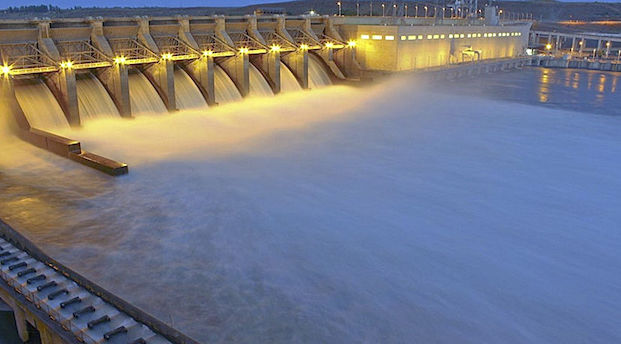forum
library
tutorial
contact

Plan with Dams' Removal
Provides Best Hope for Salmon
by Les Welsh
Everett Herald, November 21, 2021
|
the film forum library tutorial contact |

|
Plan with Dams' Removal
by Les Welsh
|
Past efforts have failed to sufficiently restore Columbian Basin runs. It's time for bold action.
 There's good news -- and historic investments -- for Washington state outlined in the $1.2 trillion Infrastructure Investment and Jobs Act, recently approved by Congress and signed by President Biden.
There's good news -- and historic investments -- for Washington state outlined in the $1.2 trillion Infrastructure Investment and Jobs Act, recently approved by Congress and signed by President Biden.
Our state will receive nearly $8.6 billion in dedidicated funds, possibly more, for projects ranging from highways and bridges to public transit and broadband. Most exciting, the legislation contains numerous provisions authored and championed by Sen. Maria Cantwell, D-Wash., to advance salmon recovery.
These salmon recovery investments are significant, welcome and timely. They come as we grapple with a rapidly escalating and urgent crisis in the Columbia River Basin, where 13 populations of salmon runs are endangered or threatened. Cantwell secured $2.85 billion in funding for culvert removal and replacement, habitat restoration, hatcheries and research to help rebuild salmon populations. By pushing these salmon recovery needs to the front burner, Cantwell is also building on the growing momentum in Washington and across the region to bring back salmon runs.
The influx of infrastructure dollars will tackle a number of pressing salmon recovery challenges, but history has demonstrated that these measures alone will not bring back salmon to abundance. We've spent more than $17 billion over two decades on salmon habitat improvements. This represents the most expensive species recovery effort in world history, yet these fish remain on the cusp of extinction.
In short, it's a historic failure.
Let's set our sights on success instead. That means having the political courage to go big. The preponderance of scientific research points us toward one remaining option, as do 68 of the nation's and Northwest region's premier salmon and fisheries scientists.
It's the option we've yet to pursue: to remove the four lower Snake River dams in Washington state.
Understandably, the prospect of removing the dams is unsettling to Northwest residents. We've all benefited from the prosperity they've brought to the region. However, outdated and having outlived their usefulness, these dams are now more of a drag than a driver on the Northwest's economy and way of life.
In Washington, there is a clear link between abundant salmon and thriving economies.
If salmon runs continue to falter and edge toward extinction, our state will pay a heavy price. Commercial and recreational fishing in Washington is estimated to support 16,000 jobs and $540 million in personal income.
This is why the investments in the infrastructure bill should be leveraged as a robust down-payment to finance a broader regional transition plan. Put simply, it's a comprehensive legislative package to upgrade and modernize the Pacific Northwest's infrastructure, energy and transportation systems, create jobs and revitalize agricultural communities.
In October, Sen. Patty Murray, D-Wash. and Go. Jay Inslee announced they were exploring comprehensive solutions, including dam breaching, and will deliver recommendations by July 31, 2022. They see what we all see: Change is coming.
The soaring temperatures of this summer's “heat dome” make this abundantly clear. A comprehensive solutions legislation package would represent not only a historic turning point for salmon, orcas and tribal justice; it is also a necessity. If we retain the Snake River dams this will strike a devastating blow for all three.
There is a historic moment before us on the political front. For the first time we have an actionable commitment from leaders in three states. Oregon's Sens. Jeff Merkley and Ron Wyden responded to the Inslee and Murray announcement by committing to collaborate on a comprehensive solution to recover Columbia Basin fish stocks. Oregon's senators join the existing commitment of Oregon's Gov. Kate Brown and Rep. Earl Blumenauer, who have stated support to breach the lower Snake River dams if their services are replaced.
Meanwhile, and perhaps most important, the Biden administration announced charting a path forward to end the Columbia River Basin conflict's between salmon and dams. A monumental step forward, the plight of Washington's fish has the attention and commitment of the U.S. executive. This is a first in this decades-long -- and wholly unsuccessful -- recovery effort. A commitment from the executive, as well as all relevant agency and department heads, is a must to pass any comprehensive solution to save our fish.
And what do a majority of Washington voters want?
A plan to remove the lower Snake River dams to prevent salmon extinction, along with accompanying investment in agriculture, energy and transportation. The call to Washington's elected leaders is clear: Make the needed investments, remove the lower Snake River dams and bring our salmon back.
That would truly be historic.
Related Pages:
Rep. Newhouse, Dams in Your District are Doing Damage to Mine by Rep. Mike Simpson, Everett Herald, 5/29/21
learn more on topics covered in the film
see the video
read the script
learn the songs
discussion forum
